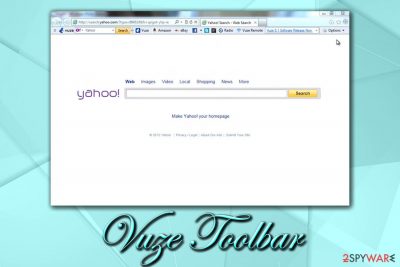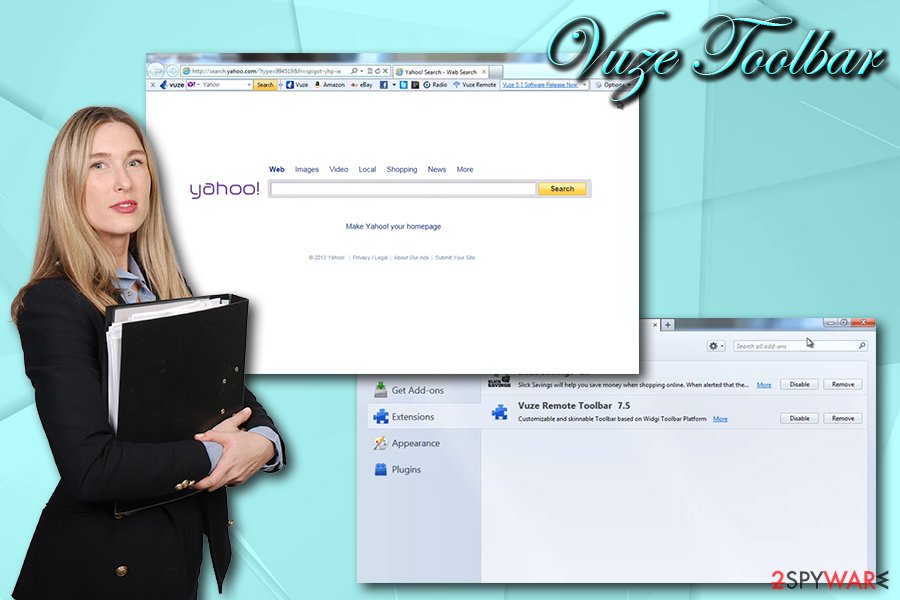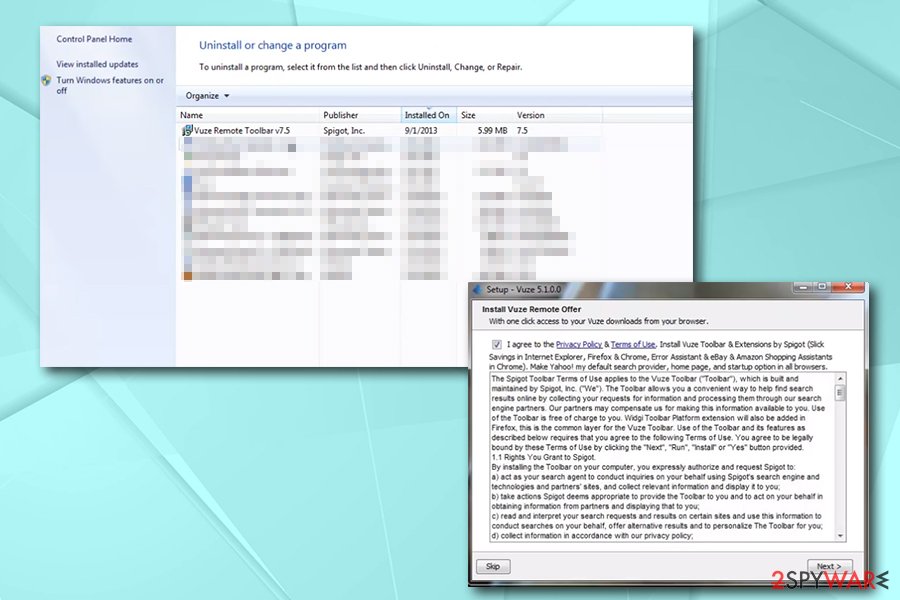Vuze Toolbar (Removal Instructions) - Free Guide
Vuze Toolbar Removal Guide
What is Vuze Toolbar?
Vuze Toolbar is a browser plugin that attaches to Google Chrome or another browser and changes its settings

Vuze Toolbar is a browser extension that is bundled together with the BitTorrent client Vuze, so users rarely notice its infiltration. The tool was actively promoted via the installer a decade ago, and, because users used to choose Recommended settings, would install the toolbar unintentionally.
Once installed, the plugin used to hijack Google Chrome, Safari, Mozilla Firefox or Internet Explorer browsers and set the homepage and new tab URL to Yahoo, which consequently would show excessive amounts of advertisement. Besides, many users complained that they were struggling with Vuze Toolbar removal at the time,[1][2], so the process often required specialized security software to terminate completely.
For all those reasons, Vuze Remote Toolbar was considered to be a type potentially unwanted program – browser hijacker.[3] These apps make changes to web browsers in order to display sponsored search results as well as cover various sites with a layer of ads. However, Vuze does not distribute the plugin anymore and provides details instructions on how to eliminate it.
| Name | Vuze Toolbar |
| Also known as | Vuze Remote Toolbar |
| Type | Browser hijacker |
| Developer | Azureus Software |
| Infiltration | Software bundles, third-party sites |
| Symptoms | Hijacked search engine and homepage, sponsored searched results, increased amount of ads on all visited sites |
| Termination | Use security software or check our manual removal guide below |
| Recovery | Because the PUP might be difficult to remove, it might leave its traces behind. To avoid that, scan your device with FortectIntego |
Those who get infected with Vuze Toolbar nowadays possibly used an old installed of the BitTorrent client, downloaded it bundled with other freeware or installed it from dodgy third-party sites. Therefore, while the infection is old, it does not mean that it might not be present.
Vuze Toolbar possesses all the features of a classic browser hijacker:
- bundled with other software, i.e., installed unintentionally;
- changes the new tab functionality and sets search engine the homepage to Yahoo;
- ads a toolbar at the top of Google Chrome, Internet Explorer, Mozilla Firefox, or Safari browsers;
- displays altered search results that are filled with sponsored links;
- is difficult to eliminate.
Be aware that, even though Vuze Remote Toolbar redirects all searches to Yahoo, the results are not organic.[4] On the contrary, they are filtered, and sponsored links are always provided on top. These links are often relative to users' interests – targeted advertisement is used in order to employ the scheme successfully. For that, information about users' web browsing habits is often collected and might include IP address, geolocation, technical details, search queries, links clicked, sites visited, cookie data, bookmarks added, etc.
If you are looking for ways how to remove Vuze Toolbar, you should check our guidelines below. As we previously mentioned, users used to struggle with the termination of the unwanted program. However, if you follow our instructions carefully, it should be easy.
In case you still do not succeed to terminate Vuze Toolbar, you should employ anti-malware software like FortectIntego – it will do the cleaning for you.

Potentially unwanted program distribution techniques
Potentially unwanted programs are usually distributed within software bundles, hosted on third-party sites or promoted via advertisement campaigns on various sites. Nevertheless, software bundling is the most probable cause of the PUP infection on most users' machines.
The latter works so well because users are often careless when it comes to the installation of freeware or shareware apps, and most don't even know that optional components are offered to them within a single software package. This is because additional programs are cleverly hidden within the installer, as freeware developers use multiple deceptive techniques such as:
- Pre-ticked boxes;
- Deliberately misplaced buttons (“Decline offer” is placed on the left side instead of the right – that is were users mostly click to continue the installation);
- Recommended settings, etc.
Thus, when you are establishing new apps, make sure you never skip through steps and always pick Advanced or Custom settings instead of Recommended/Quick ones.
Delete Vuze Remote Toolbar from your device
While initially a PUP is not a significant computer threat, its prolonged usage might compromise your online safety and increase the risk of malware infections. Therefore, if you found changes made to your browser without your consent, you should remove Vuze Toolbar as soon as possible. You can do it either manually or automatically – use our guide below or scan your machine with anti-malware software.

Manual Vuze Toolbar might sometimes not be successful, however. If that is the case, you should scan your computer with anti-malware software, as it would terminate all the unwanted components and traces belonging to the hijacker.
Finally, as soon as you delete Vuze Remote Toolbar, you should also reset each of the installed browsers, as its altered settings will still be present.
You may remove virus damage with a help of FortectIntego. SpyHunter 5Combo Cleaner and Malwarebytes are recommended to detect potentially unwanted programs and viruses with all their files and registry entries that are related to them.
Getting rid of Vuze Toolbar. Follow these steps
Uninstall from Windows
To remove Vuze Toolbar from the Windows operating system, you will have to access Control Panel:
Instructions for Windows 10/8 machines:
- Enter Control Panel into Windows search box and hit Enter or click on the search result.
- Under Programs, select Uninstall a program.

- From the list, find the entry of the suspicious program.
- Right-click on the application and select Uninstall.
- If User Account Control shows up, click Yes.
- Wait till uninstallation process is complete and click OK.

If you are Windows 7/XP user, proceed with the following instructions:
- Click on Windows Start > Control Panel located on the right pane (if you are Windows XP user, click on Add/Remove Programs).
- In Control Panel, select Programs > Uninstall a program.

- Pick the unwanted application by clicking on it once.
- At the top, click Uninstall/Change.
- In the confirmation prompt, pick Yes.
- Click OK once the removal process is finished.
Delete from macOS
If your Mac is suffering from adware symptoms, you should perform the following steps:
Remove items from Applications folder:
- From the menu bar, select Go > Applications.
- In the Applications folder, look for all related entries.
- Click on the app and drag it to Trash (or right-click and pick Move to Trash)

To fully remove an unwanted app, you need to access Application Support, LaunchAgents, and LaunchDaemons folders and delete relevant files:
- Select Go > Go to Folder.
- Enter /Library/Application Support and click Go or press Enter.
- In the Application Support folder, look for any dubious entries and then delete them.
- Now enter /Library/LaunchAgents and /Library/LaunchDaemons folders the same way and terminate all the related .plist files.

Remove from Microsoft Edge
Delete unwanted extensions from MS Edge:
- Select Menu (three horizontal dots at the top-right of the browser window) and pick Extensions.
- From the list, pick the extension and click on the Gear icon.
- Click on Uninstall at the bottom.

Clear cookies and other browser data:
- Click on the Menu (three horizontal dots at the top-right of the browser window) and select Privacy & security.
- Under Clear browsing data, pick Choose what to clear.
- Select everything (apart from passwords, although you might want to include Media licenses as well, if applicable) and click on Clear.

Restore new tab and homepage settings:
- Click the menu icon and choose Settings.
- Then find On startup section.
- Click Disable if you found any suspicious domain.
Reset MS Edge if the above steps did not work:
- Press on Ctrl + Shift + Esc to open Task Manager.
- Click on More details arrow at the bottom of the window.
- Select Details tab.
- Now scroll down and locate every entry with Microsoft Edge name in it. Right-click on each of them and select End Task to stop MS Edge from running.

If this solution failed to help you, you need to use an advanced Edge reset method. Note that you need to backup your data before proceeding.
- Find the following folder on your computer: C:\\Users\\%username%\\AppData\\Local\\Packages\\Microsoft.MicrosoftEdge_8wekyb3d8bbwe.
- Press Ctrl + A on your keyboard to select all folders.
- Right-click on them and pick Delete

- Now right-click on the Start button and pick Windows PowerShell (Admin).
- When the new window opens, copy and paste the following command, and then press Enter:
Get-AppXPackage -AllUsers -Name Microsoft.MicrosoftEdge | Foreach {Add-AppxPackage -DisableDevelopmentMode -Register “$($_.InstallLocation)\\AppXManifest.xml” -Verbose

Instructions for Chromium-based Edge
Delete extensions from MS Edge (Chromium):
- Open Edge and click select Settings > Extensions.
- Delete unwanted extensions by clicking Remove.

Clear cache and site data:
- Click on Menu and go to Settings.
- Select Privacy, search and services.
- Under Clear browsing data, pick Choose what to clear.
- Under Time range, pick All time.
- Select Clear now.

Reset Chromium-based MS Edge:
- Click on Menu and select Settings.
- On the left side, pick Reset settings.
- Select Restore settings to their default values.
- Confirm with Reset.

Remove from Mozilla Firefox (FF)
Reset Mozilla Firefox as soon as you delete the unwanted app:
Remove dangerous extensions:
- Open Mozilla Firefox browser and click on the Menu (three horizontal lines at the top-right of the window).
- Select Add-ons.
- In here, select unwanted plugin and click Remove.

Reset the homepage:
- Click three horizontal lines at the top right corner to open the menu.
- Choose Options.
- Under Home options, enter your preferred site that will open every time you newly open the Mozilla Firefox.
Clear cookies and site data:
- Click Menu and pick Settings.
- Go to Privacy & Security section.
- Scroll down to locate Cookies and Site Data.
- Click on Clear Data…
- Select Cookies and Site Data, as well as Cached Web Content and press Clear.

Reset Mozilla Firefox
If clearing the browser as explained above did not help, reset Mozilla Firefox:
- Open Mozilla Firefox browser and click the Menu.
- Go to Help and then choose Troubleshooting Information.

- Under Give Firefox a tune up section, click on Refresh Firefox…
- Once the pop-up shows up, confirm the action by pressing on Refresh Firefox.

Remove from Google Chrome
Delete malicious extensions from Google Chrome:
- Open Google Chrome, click on the Menu (three vertical dots at the top-right corner) and select More tools > Extensions.
- In the newly opened window, you will see all the installed extensions. Uninstall all the suspicious plugins that might be related to the unwanted program by clicking Remove.

Clear cache and web data from Chrome:
- Click on Menu and pick Settings.
- Under Privacy and security, select Clear browsing data.
- Select Browsing history, Cookies and other site data, as well as Cached images and files.
- Click Clear data.

Change your homepage:
- Click menu and choose Settings.
- Look for a suspicious site in the On startup section.
- Click on Open a specific or set of pages and click on three dots to find the Remove option.
Reset Google Chrome:
If the previous methods did not help you, reset Google Chrome to eliminate all the unwanted components:
- Click on Menu and select Settings.
- In the Settings, scroll down and click Advanced.
- Scroll down and locate Reset and clean up section.
- Now click Restore settings to their original defaults.
- Confirm with Reset settings.

Delete from Safari
Remove unwanted extensions from Safari:
- Click Safari > Preferences…
- In the new window, pick Extensions.
- Select the unwanted extension and select Uninstall.

Clear cookies and other website data from Safari:
- Click Safari > Clear History…
- From the drop-down menu under Clear, pick all history.
- Confirm with Clear History.

Reset Safari if the above-mentioned steps did not help you:
- Click Safari > Preferences…
- Go to Advanced tab.
- Tick the Show Develop menu in menu bar.
- From the menu bar, click Develop, and then select Empty Caches.

After uninstalling this potentially unwanted program (PUP) and fixing each of your web browsers, we recommend you to scan your PC system with a reputable anti-spyware. This will help you to get rid of Vuze Toolbar registry traces and will also identify related parasites or possible malware infections on your computer. For that you can use our top-rated malware remover: FortectIntego, SpyHunter 5Combo Cleaner or Malwarebytes.
How to prevent from getting browser hijacker
Choose a proper web browser and improve your safety with a VPN tool
Online spying has got momentum in recent years and people are getting more and more interested in how to protect their privacy online. One of the basic means to add a layer of security – choose the most private and secure web browser. Although web browsers can't grant full privacy protection and security, some of them are much better at sandboxing, HTTPS upgrading, active content blocking, tracking blocking, phishing protection, and similar privacy-oriented features. However, if you want true anonymity, we suggest you employ a powerful Private Internet Access VPN – it can encrypt all the traffic that comes and goes out of your computer, preventing tracking completely.
Lost your files? Use data recovery software
While some files located on any computer are replaceable or useless, others can be extremely valuable. Family photos, work documents, school projects – these are types of files that we don't want to lose. Unfortunately, there are many ways how unexpected data loss can occur: power cuts, Blue Screen of Death errors, hardware failures, crypto-malware attack, or even accidental deletion.
To ensure that all the files remain intact, you should prepare regular data backups. You can choose cloud-based or physical copies you could restore from later in case of a disaster. If your backups were lost as well or you never bothered to prepare any, Data Recovery Pro can be your only hope to retrieve your invaluable files.
- ^ How to get rid of vuze toolbar in chrome?. Yahoo Answers. Question-and-answer website .
- ^ How to remove Vuze Remote Toolbar v10.5. Reddit. Social Network.
- ^ Margaret Rouse. Browser hijacker (browser hijacking). SearchSecurity. Information Security information, news and tips.
- ^ rganic Search: What Is Organic Search?. WordStream. Online advertising company.























